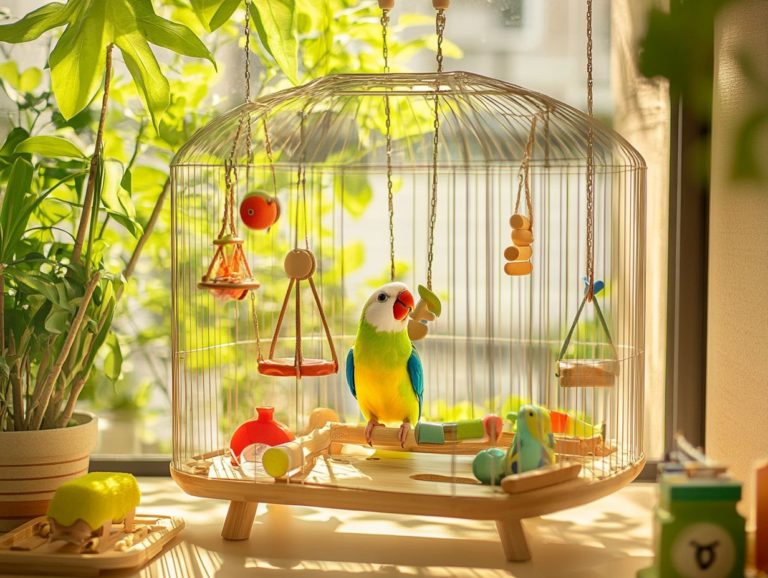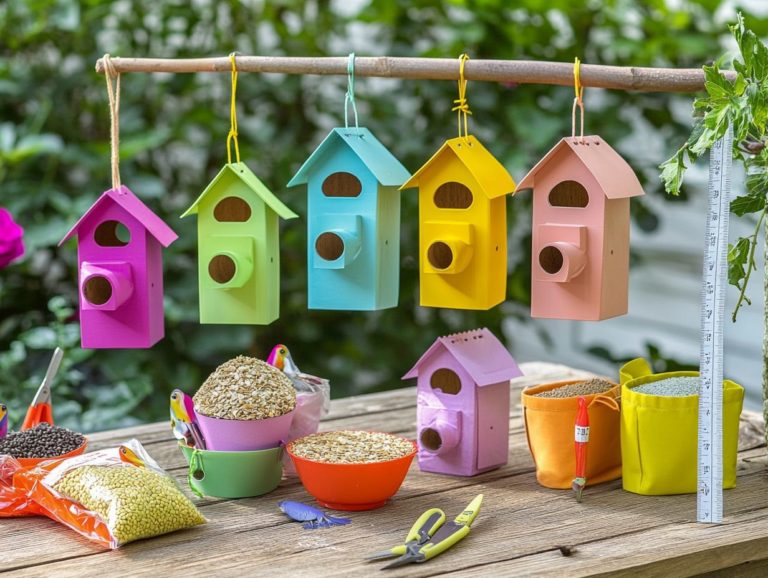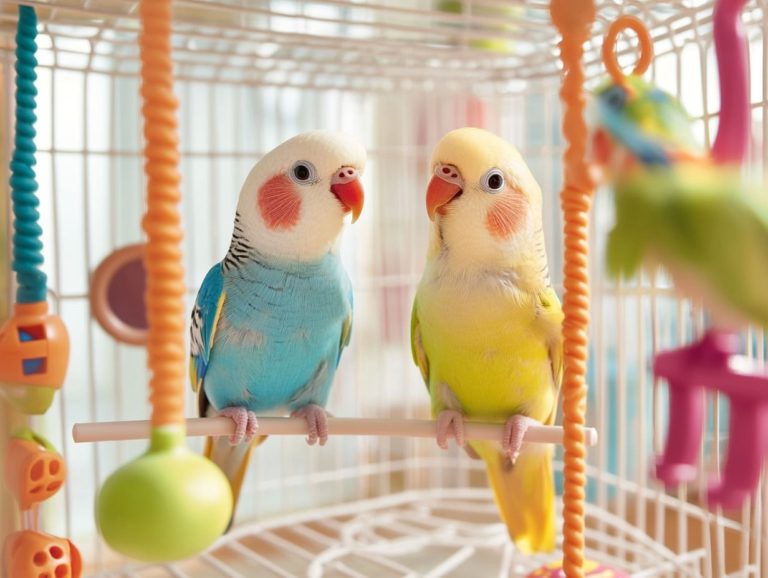How to Choose the Right Size of Bird Toys
Choosing the right size of toys is crucial for your bird’s happiness and health! The right toys not only boost their physical health but also stimulate their natural behaviors. This creates a vibrant and engaging environment.
You will also explore key factors to consider when selecting toys. You ll delve into the various types available and receive practical tips to ensure a perfect fit for your bird. Plus, you ll learn how to maintain toys for safe and enjoyable playtime.
Read on to discover how to enrich your bird s life with the ideal toys!
Contents
- Key Takeaways:
- Importance of Choosing the Right Size of Bird Toys
- Factors to Consider when Choosing Bird Toys
- Types of Bird Toys
- Tips for Choosing the Right Size of Bird Toys
- Proper Maintenance and Replacement of Bird Toys
- Frequently Asked Questions
- What factors should I consider when choosing the right size of bird toys?
- Why is it important to choose the right size of bird toys?
- How can I determine the appropriate size of toys for my bird?
- What are some common sizes of bird toys?
- Can I modify the size of bird toys if necessary?
- What should I do if my bird seems uninterested in their toys?
Key Takeaways:

- Bird toys of the right size promote healthy physical and mental stimulation for your feathered friend.
- Consider your bird’s species and size, along with the materials and durability of the toys when making a purchase.
- Maintaining and replacing bird toys ensures your bird’s safety and continued enjoyment.
Importance of Choosing the Right Size of Bird Toys
Selecting the appropriate size of bird toys is essential for your pet’s well-being, as it significantly impacts their mental stimulation and physical activity. Understanding your bird’s play style and toys can further enhance their play experience.
The dimensions of these toys influence how your birds engage with them. This affects their natural behaviors and helps prevent destructive tendencies, especially in species like parrots, cockatoos, and macaws.
Choosing the right size enhances cognitive enrichment and encourages safe play. It also reduces the likelihood of behavioral issues linked to ill-fitting toys. To ensure you make informed choices, refer to guides on understanding bird toy materials and safety. This thoughtful approach promotes overall bird health and ensures the toys remain safe for their enjoyment.
Impact on Bird’s Health and Behavior
Bird toys play a huge role in keeping your feathered friend healthy and happy! These toys offer essential mental stimulation that encourages natural behaviors and minimizes behavioral issues.
By providing a diverse range of toys like foraging puzzles, swings, and chewable items you can inspire exploration and play. This allows your bird to embrace its instinctual tendencies.
For instance, foraging toys cleverly stimulate your bird’s natural hunting instincts by hiding treats. This prompts problem-solving and engagement. Chewable toys fulfill the vital need to gnaw, promoting beak health, while swings and climbing structures enhance physical exercise and coordination.
Ultimately, a carefully curated selection of enrichment activities keeps your bird entertained. It significantly boosts its overall well-being, reduces stress, and nurtures a happier, healthier companion.
Factors to Consider when Choosing Bird Toys
When choosing bird toys, consider several key factors to ensure they meet the needs of your pet birds. Focus on the materials used, safety features, and durability.
These elements are essential for promoting healthy play and keeping your feathered friends engaged.
Bird Species and Size
Understanding the specific bird species you have is crucial for selecting the right size of bird toys. Different species, such as parrots, cockatoos, and macaws, each have unique physical activity levels and play needs.
Larger birds like macaws require robust toys that can withstand their powerful beaks and vigorous play. Smaller species, such as budgerigars, thrive on lightweight toys that encourage their natural instincts to climb and explore.
It s important to ensure the toys you choose fit comfortably within their living spaces and align with their instincts be it foraging or chewing. This thoughtful selection significantly enhances their overall well-being. Tailoring the size and type of toys to cater to these natural behaviors not only keeps them engaged but also promotes a healthy, active lifestyle.
Toy Materials and Durability

When selecting bird toys, the choice of materials is crucial. Opt for durable and safe options like wood and acrylic, especially for chewing toys and interactive play.
Choosing the right materials extends the lifespan of the toys. It also prioritizes your bird s safety. Wooden toys are particularly favored for their natural durability, providing an excellent outlet for your bird’s instinct to chew.
These toys keep boredom at bay while promoting physical activity as your bird engages with them. The varied textures and shapes of wooden toys encourage beak exercise and stimulate the mind.
This creates an enriching environment that nurtures your bird’s well-being. Consider the safety of the materials. It directly impacts your bird’s health and happiness.
Types of Bird Toys
You ll find a wide array of bird toys crafted to address the unique needs of pet birds. From interactive toys that stimulate play and engagement to foraging toys that encourage exploration and mental challenge, each type is designed to cater to various play styles and preferences.
Interactive Toys
Interactive toys are essential for providing mental stimulation and companionship to your pet birds. They encourage play that closely resembles their natural behaviors.
These toys help prevent boredom, which can spiral into stress and destructive habits. For example, puzzle feeders challenge your bird’s intellect while rewarding them with treats. They satisfy foraging instincts in a delightful way.
Shreddable toys made from safe, natural materials promote healthy beak maintenance and allow your birds to express their innate tendencies. Toys that incorporate sound or movement elevate social interaction, prompting your birds to vocalize or engage playfully with you.
Incorporating a diverse array of these toys into your bird’s environment significantly enhances their overall welfare and happiness.
Foraging Toys
Foraging toys ignite your bird’s natural foraging instincts. They invite your bird into activities that enhance both cognitive function and physical vitality.
These fun toys let your bird explore and tackle challenges. They satisfy their intrinsic urge to search for food. By uncovering hidden treats or navigating complex puzzles, foraging toys keep your feathered friend mentally sharp.
They also help prevent boredom that can lead to undesirable behaviors, such as incessant squawking or feather plucking. As a bird owner, it’s vital to appreciate the significance of these toys in nurturing a happier, healthier, and more well-adjusted avian companion.
Perches and Swings
Perches and swings are vital components of bird toys. They offer your feathered friends opportunities for physical activity that greatly enhance their overall health and well-being.
These essential features encourage your birds to exercise. This is crucial for maintaining a healthy weight and warding off obesity. They also provide mental stimulation.
By incorporating a variety of materials and textures, the right perches help prevent foot-related ailments. This ensures your birds feet stay in excellent condition. Platforms and swings create engaging environments that promote exploration and social interaction.
Get your birds moving today! By ensuring their habitat includes diverse perching options tailored to their species, you encourage natural behaviors. This allows your avian companions to thrive both physically and emotionally.
Tips for Choosing the Right Size of Bird Toys

Choose the right size bird toys carefully, as this ensures safety and keeps your bird engaged during playtime. For more information, consider selecting safe chew toys for your bird.
Measurements and Proportions
Accurate measurements and proportions are essential for bird toys. They create a safe and comfortable space for your pet bird.
Consider the dimensions carefully. The right size promotes active play and minimizes hazards.
For smaller birds like parakeets, choose toys that are 4 to 8 inches long. This size helps them grasp and use the toys safely.
Larger birds, such as cockatoos, enjoy toys that are 10 to 16 inches long. These provide room for climbing and chewing.
Remember that the thickness of ropes and perches should fit your bird’s size. Thin ropes can choke larger birds, while thick branches may overwhelm smaller birds.
Observing Your Bird’s Preferences
Pay attention to what your bird enjoys. This allows you to tailor enrichment activities to their play styles.
Watch for cues that indicate their preferences. Take note of which toys they like and how they interact with different materials.
Keep your bird excited by regularly rotating their toys! This helps maintain their enthusiasm and contributes to their mental well-being.
Proper Maintenance and Replacement of Bird Toys
Keeping bird toys clean and replacing them on time is essential for your birds’ health. Worn toys can pose health risks, so always watch for signs of wear.
Cleaning and Disinfecting
Cleaning your bird’s toys is vital to their safety and health. Regular cleaning reduces the risk of infections.
Use warm, soapy water or bird-safe disinfectants to clean toys effectively. This not only kills harmful germs but also extends the life of the toys.
Inspect toys for wear and tear regularly. This shows your commitment to your bird’s well-being and keeps playtime enjoyable.
When to Replace Toys

Look for signs that indicate it’s time to replace toys. Common indicators include frayed ropes and sharp edges.
When toys lose their shape or no longer engage your pet, it can lead to boredom and frustration. Replace worn toys to keep your bird happy.
Regularly introducing new, safe toys keeps your bird interested and encourages playful exploration. This supports a happy, healthy companion.
Frequently Asked Questions
What factors should I consider when choosing the right size of bird toys?
Consider your bird’s species and size. Also, look at the toy’s materials and construction to ensure safety and fun.
Why is it important to choose the right size of bird toys?
Choosing the right size of bird toys is crucial for their safety. If the toys are too small, they can choke. Toys that are too large may be hard for your bird to use. Understanding the importance of variety in bird toys ensures that the right size keeps your bird mentally and physically active.
How can I determine the appropriate size of toys for my bird?
Check the size guidelines for your bird’s species to find the right toys. Additionally, you can learn how to safely use bird toys with multiple birds by observing your bird’s play habits and choosing toys similar to their favorites.
What are some common sizes of bird toys?
Bird toys come in different sizes: small, medium, and large. Small toys suit finches and canaries, while medium ones fit cockatiels and conures. Large toys are perfect for macaws and cockatoos.
Can I modify the size of bird toys if necessary?
You can change the size of bird toys if needed. Add string or rope to make a toy longer for bigger birds, or trim it for smaller ones. Always supervise your bird to ensure the modifications are safe.
What should I do if my bird seems uninterested in their toys?
If your bird ignores their toys, try offering different sizes and types. Rotate the toys regularly to spark their interest. If they still seem disinterested, they may need more of your attention.






